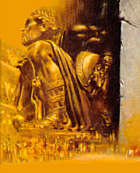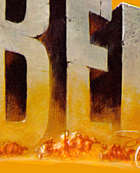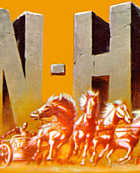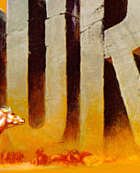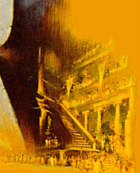The long awaited, at least by your Curator, new transfer of MGM's ultimate achievement has at long last reached us. With a few notable exceptions, the previous DVD issued by Warner Home Video must be considered quite good. So how much improvement do we see in the new, higher priced, more feature-laden version? Let's have a look and a listen. We'll start our comparison by looking at the cover art. Seem's a bit odd, but bear with me, there are things to discuss here.
Part One
Compare The Packaging
  While it is absolutely necessary to distinguish the new version from the old, who came up with the color scheme that seems to bear no resemblance to anything associated with this well known movie? Printing the title graphic in a bas relief is a nice touch but the Curator is going to have to spend some time getting used to the goofy colors. (The chariot race on lush grass?) But this is nit-picking based on the Curator's personal sensibilities. Let's now look at the backs of these two packages.
While it is absolutely necessary to distinguish the new version from the old, who came up with the color scheme that seems to bear no resemblance to anything associated with this well known movie? Printing the title graphic in a bas relief is a nice touch but the Curator is going to have to spend some time getting used to the goofy colors. (The chariot race on lush grass?) But this is nit-picking based on the Curator's personal sensibilities. Let's now look at the backs of these two packages.
 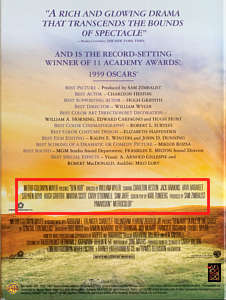 Note the areas outlined in red. These are the credit blocks for the film. Below are copies of those areas. You will note that the text is the same. And that's what bugs the Curator. He assumed that after the first release someone at WHV would have caught and corrected the errors. This is more nit picking but it should not have happened. Errors on DVD packages seem to be the rule more than the exception.
Note the areas outlined in red. These are the credit blocks for the film. Below are copies of those areas. You will note that the text is the same. And that's what bugs the Curator. He assumed that after the first release someone at WHV would have caught and corrected the errors. This is more nit picking but it should not have happened. Errors on DVD packages seem to be the rule more than the exception.

 In case you haven't spotted the goof, here are the title cards from the film:
In case you haven't spotted the goof, here are the title cards from the film:
 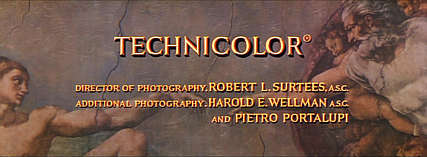
And one more thing that peaved the Curator
 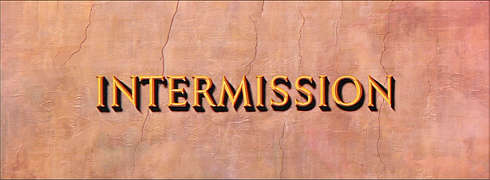
Hooray!A fix has been made to the Intermission title card. In the original DVD release, for reasons that can not possibly hold water, a crappy Photoshop job replaced the beautiful artwork done by Pacific Title for the film. In the new release we are given the actual title, and doesn't it look a lot better?
And One Last BIG Gripe!
 
It is a sad fact of life that few people assembling video transfers recognize that audiences are capable of figuring out that overtures are played without a picture. This has confused theatre operators that run prints of classic roadshow films and they think that the curtains are supposed to be open for the pre-picture music. While it's nice that the new DVD has at least attempted to match the lettering used by Pacific Title, roadshow films should have nothing on the screen during the overture. The only company that has done this is 20th Century Fox Home Video, and they're not consistent. The worst part of this intrusion on the music is that it shows the audience a title graphic that they will see later on, and that artwork is electrifying when it appears. If the folks at Warner Home Video and virtually all the other companies insist on putting something on screen, how about small gray letters in the corner of a black screen, as illustrated below? Serving Suggestion
 The American WideScreen Museum endorses this artwork in all cases where an overture is part of a roadshow film and it is just absolutely, positively necessary to put something on the screen. Further, it suggests that the text fade out after people with minimal reading skills have had a chance to comprehend its meaning. This artwork is released into the public domain for any and all that want to use it. The same treatment should be used for all closed curtain music including entr'acte during the intermission and exit music following the end title. The American WideScreen Museum endorses this artwork in all cases where an overture is part of a roadshow film and it is just absolutely, positively necessary to put something on the screen. Further, it suggests that the text fade out after people with minimal reading skills have had a chance to comprehend its meaning. This artwork is released into the public domain for any and all that want to use it. The same treatment should be used for all closed curtain music including entr'acte during the intermission and exit music following the end title.
MORE

|





